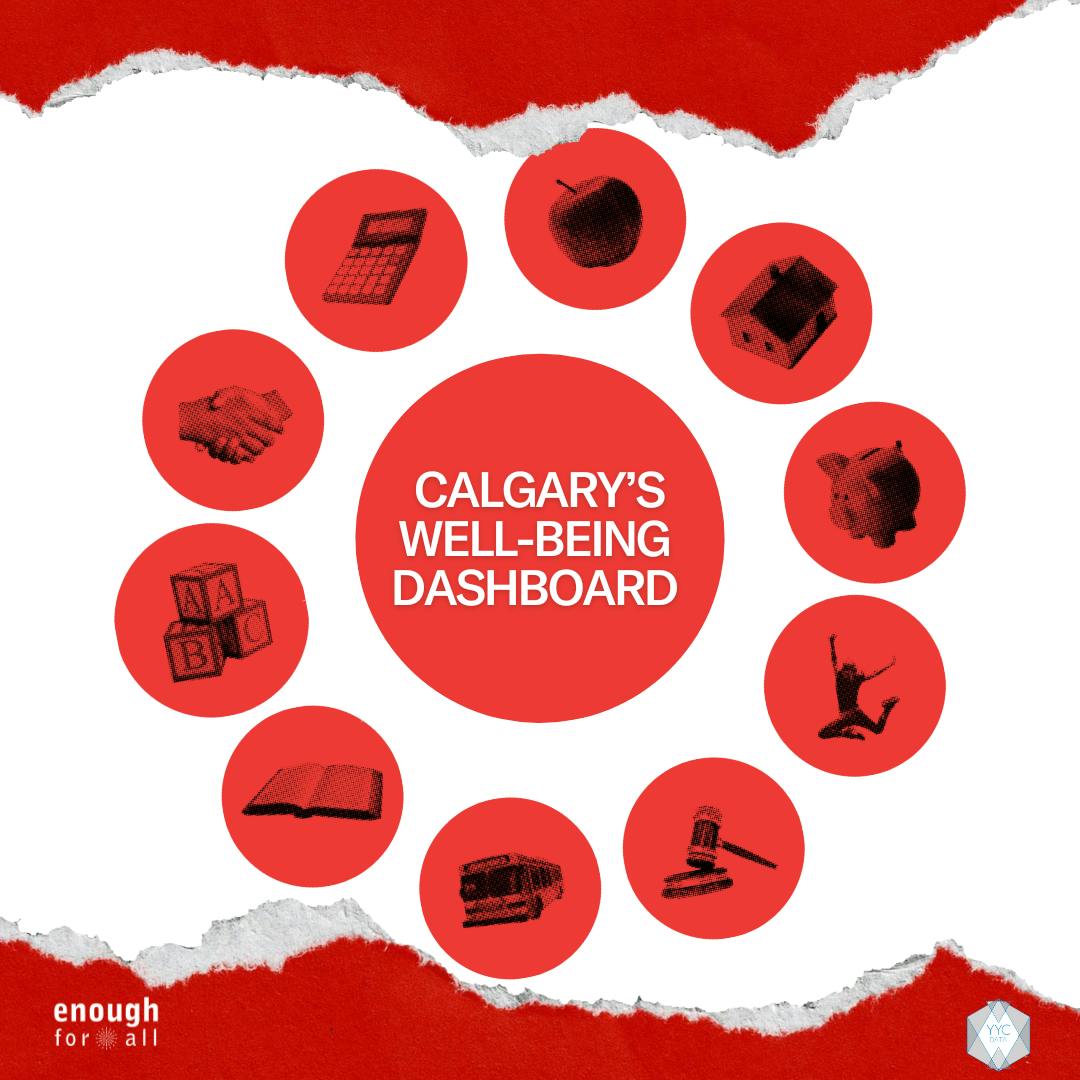Article
Calgary’s working poor population continues to rise as high school completion rates trend downward
A closer look at the latest data on income, transit, education, and mental health in Calgary
3 November 2025

The Enough for All (E4A) Well-Being Dashboard, developed in partnership with YYC Data, showcases vital data demonstrating Calgary’s progress toward achieving its poverty-reduction goals. Following several years of community consultation and recommendations in the evaluation report, Vibrant Communities Calgary (VCC) and Enough for All Champions agreed on key indicators to better measure poverty reduction.
Here are the latest updates to the dashboard:
Working poor refers to people aged 18-64 who earn more than $3,000 in employment income but have after-tax income below the Low-Income Measure (LIM). The portion of the workforce not earning enough to adequately support themselves is an important indicator of how well Calgary’s economy is serving those earning the least. The LIM defines poverty as having an income below 50% of the median household income, adjusted for family size.
In 2023, the number of people qualifying as working poor in Calgary increased to 5.6% from 5.3% in 2022. This represented an almost 6% year-over-year increase and marked the third consecutive year of increases. Concerningly, whereas other cities such as Vancouver and Toronto saw their working poor rates remain relatively flat in 2023, Calgary’s continued to grow, now exceeding pre-pandemic levels. Rates in Toronto and Vancouver are still below pre-pandemic levels. Though at 5.6%, Calgary’s working poor rate is below Toronto (7.2%) and Vancouver (5.9%).
The three-year high school completion rate reflects the percentage of students who graduate high school within three years of starting grade 10. Three-year graduation rates are particularly important when evaluating the education system, as they speak to efficiency, provide feedback on the appropriateness of the curriculum, and demonstrate how well students are supported in meeting learning objectives. When these rates fall, it may signal problems in our school systems.
Alberta’s three-year high school completion rate fell from 80.7% in 2022 to 80.4% in 2023. This represented a 0.4% year-over-year decrease and marked the third consecutive year that 3-year graduation rates have fallen in the province. In Calgary, the Calgary Board of Education reported that its three-year high school graduation rate had fallen 0.9% from 81.1% in 2022 to 80.4% in 2023. Overall, this is concerning as education is a key driver of prosperity, and research has shown that educational attainment is correlated with economic success.
Transit ridership is an estimated number of trips taken on a public transportation system and is an important indicator of a city’s well-being. An effective public transit system can encourage economic growth by enabling residents to commute more easily to work, shopping, and appointments. Transit ridership also reflects how fair and accessible a city’s transportation system is, as reliable transit enables people with low incomes or disabilities who do not have access to a car to get around.
In 2024, Calgary Transit’s ridership reached an estimated 101 million unique trips, up from 90 million in 2023—more than 12% increase. This marks the third consecutive year of ridership growth. However, ridership has yet to reach pre-pandemic levels. In 2019, an estimated 106 million unique trips were taken on Calgary’s public transit system.
The MNP Consumer Debt Index is a quarterly statistic that provides insight into how Canadians feel about their ability to manage their debt. MNP is a Canadian financial institution that provides insolvency-related services. The Consumer Debt Index is a composite score collected via survey, where a higher number reflects more confidence in people’s ability to manage their debt.
In Q2 of 2025, the Canadian consumer debt index remained unchanged from Q1 at 88. Year over year, this marked a 3.5% improvement from 85 in Q2 of 2024. However, over the past half-decade, the value has been trending downward, suggesting that Canadians are finding it increasingly difficult to manage their debt levels.
Self-perceived mental health is one of the most direct measures of well-being captured by the dashboard. Each year, the Calgary Foundation conducts a Quality of Life survey of 1,000 Calgarians that asks respondents about their mental health.
In 2025, 57% of those surveyed reported good mental health. This represented an increase of 1.8% from 56% in 2024. Though the increase is a positive sign, this still indicates that a sizable number of respondents reported sub-optimal mental health. Furthermore, 57% is well below the 2018 value, when 66% of respondents reported good mental health. Additionally, students, unemployed Calgarians and older youth (ages 18-24) were less likely to report good mental health. Mental health likely represents an important area of focus for Calgary’s policymakers going forward.
About the dashboard
The Enough for All Well-Being Dashboard builds on VCC’s 2023 report, Beneath the Surface: The Layers of Poverty in Calgary. Developed in collaboration with 12 subject matter experts across nine domains of well-being, the report highlights the complex and interconnected factors that influence poverty in our city. By broadening the lens beyond traditional financial metrics, the dashboard helps tell a fuller story of well-being in Calgary and the work ahead to improve lives in our city.
The dashboard is updated regularly, as new data becomes available. Some data sources, such as the Canadian Income Survey published by Statistics Canada, are always two years behind.

Stay informed!
- Explore more of the key indicators in the Enough for All Well-Being Dashboard
- Read about the complex and interconnected factors that influence poverty in our city
- Keep up to date on the latest research, policy projects, and key events happening in our city by subscribing to the Enough for All monthly newsletter
Related Articles
Alberta gig workers push for recognition as unstable incomes, burnout take toll
New research from the Calgary Social Policy Collaborative reveals insights into trends, challenges and solutions for Alberta's gig workers

New research sheds light on Alberta’s gig economy
Calgary Social Policy Collaborative’s new report exposes the pressures facing Alberta’s gig workers and the policy tools that could better support them

Vibrant Communities Calgary addresses Council during budget deliberations
VCC’s advocacy to Calgary City Council on key social issues was covered by the Calgary Herald and Sun, and LiveWire Calgary.

